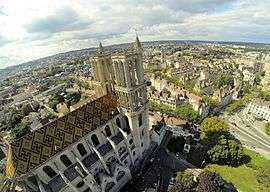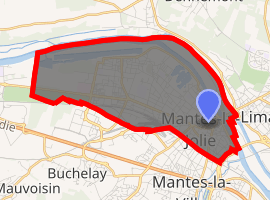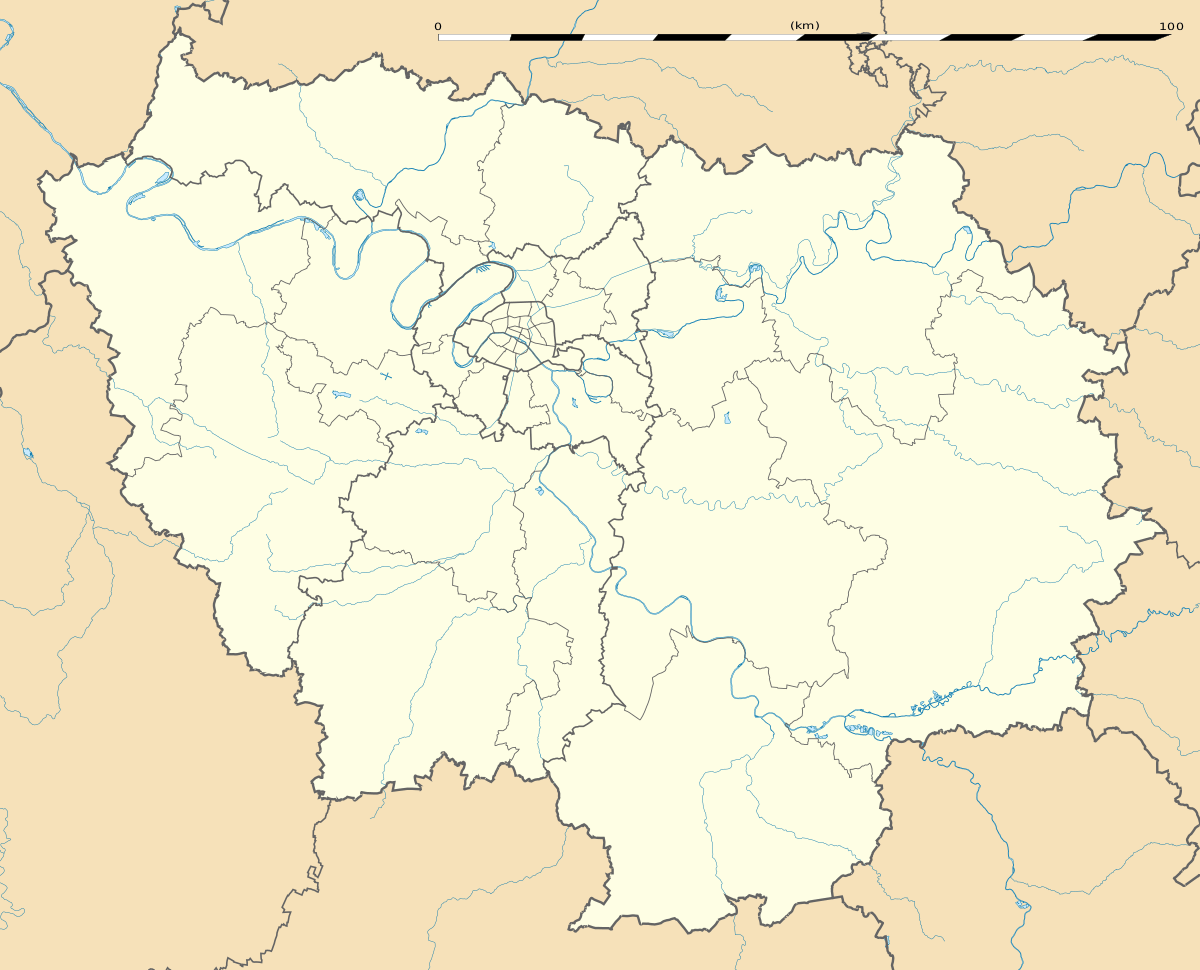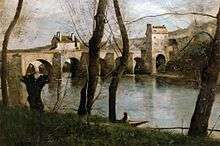Mantes-la-Jolie
Mantes-la-Jolie (French: [mɑ̃t.la.ʒɔli] (![]()
Mantes-la-Jolie | |
|---|---|
Subprefecture and commune | |
 The Collegiate Church of Notre-Dame de Mantes | |
 Coat of arms | |
Location of Mantes-la-Jolie 
| |
 Mantes-la-Jolie  Mantes-la-Jolie | |
| Coordinates: 48°59′27″N 1°43′02″E | |
| Country | France |
| Region | Île-de-France |
| Department | Yvelines |
| Arrondissement | Mantes-la-Jolie |
| Canton | Mantes-la-Jolie |
| Intercommunality | CU Grand Paris Seine et Oise |
| Government | |
| • Mayor (2014–2020) | Michel Vialay |
| Area 1 | 9.38 km2 (3.62 sq mi) |
| Population (2017-01-01)[1] | 44,299 |
| • Density | 4,700/km2 (12,000/sq mi) |
| Time zone | UTC+01:00 (CET) |
| • Summer (DST) | UTC+02:00 (CEST) |
| INSEE/Postal code | 78361 /78200 |
| Elevation | 17–41 m (56–135 ft) (avg. 34 m or 112 ft) |
| 1 French Land Register data, which excludes lakes, ponds, glaciers > 1 km2 (0.386 sq mi or 247 acres) and river estuaries. | |
History
Mantes was halfway between the centres of power of the dukes of Normandy at Rouen and the Kings of France at Paris. Along with most of northern France, it changed hands frequently in the Hundred Years' War. Philip Augustus died at Mantes, 14 July 1223.
Louis XIV instituted the manufacture of musical instruments in Mantes, and it was chosen as the centre of brass and woodwind instrument manufacture. In the 19th century, painters were attracted to the town, particularly Corot, whose paintings of the bridge and the cathedral are celebrated. Prokofiev spent the summer of 1920 there orchestrating the ballet Chout.
Originally officially called Mantes-sur-Seine (meaning "Mantes upon Seine"), Mantes merged with the commune of Gassicourt in 1930 and the commune born of the merger was called Mantes-Gassicourt.
Mantes was the location of the first allied bridgehead across the Seine on 19 August 1944, by General Patton's 3rd Army. Major rebuilding was needed after the war.
On 7 May 1953, the commune of Mantes-Gassicourt was officially renamed Mantes-la-Jolie (meaning "Mantes the pretty"), allegedly in reference to a letter of King Henry IV addressed to his mistress Gabrielle d'Estrées who resided in Mantes: "I am on my way to Mantes, my pretty" (French: je viens à Mantes, ma jolie).
Art

At the end of the 19th century, Impressionist painters like Pierre-Auguste Renoir, Édouard Manet and Claude Monet came to paint the Seine River which crosses the town. Jean Batiste Corot painting of the Old Mantes bridge is shown at the Louvres
Population
Inhabitants are called Mantais. The city had a total of 44,985 inhabitants in 2014.
The city is divided into four districts each with a characteristic urban form:
- Centre-ville: city center, a dense and commercial area
- Gassicourt: residential area
- Val Fourré: large housing district
- Hautes Garennes: a non-urbanized area
Sights
%2C_coll%C3%A9giale_Notre-Dame%2C_vue_g%C3%A9n%C3%A9rale_depuis_le_nord_6.jpg)
The main monument in Mantes is the church of Notre-Dame dating back to 12th century. A previous church was burnt down by William the Conqueror together with the rest of the town, at the capture of which he lost his life in 1087. Modern bridges link Mantes with the town of Limay on the other side of the river.
Economy
Mantes is home to small businesses working on concrete and chemical processing, but is inevitably drawn into the economic area of nearby Paris.
It is historically and at present a center of musical instrument manufacturing. The well known Buffet Crampon woodwind factory is located in the neighbourhood city of Mantes-la-Ville.
Transportation
Mantes-la-Jolie is served by two stations on the Transilien Paris – Saint-Lazare and Transilien Paris – Montparnasse suburban rail lines: Mantes-Station and Mantes-la-Jolie. The Gare de Mantes-la-Jolie is also served by TGV trains towards Le Havre, and Cherbourg.
Education
The municipality has nineteen public preschools,[2] sixteen public elementary schools,[3] six public junior high schools, two public senior high schools/sixth form colleges, and a private secondary school.[4]
Public junior high schools:
- Collège André Chénier
- Collège Paul Cézanne
- Collège Jules Ferry
- Collège Louis Pasteur
- Collège de Gassicourt
- Collège Georges Clemenceau
Public senior high schools:
- Lycée Saint-Exupéry
- Lycée Polyvalent Jean Rostand
Private secondary schools:
- Collège-Lycée Notre-Dame
Colleges and universities:
International relations
Mantes-la-Jolie is twinned with:[5]



Notable people
- Nicolas Bernier (1664–1734), composer.
- Jonathan Bumbu, footballer
- Faudel (1978), singer
- Sandy Casar (1979), cyclist
- Benoit Poher (1979), singer
- Angelo Tsagarakis (1984) basketball player
- Saïd Hireche (1985), rugby player
- Moussa Sow (*1986), footballer
- Haoua Kessely (*1988) athlete
- Omar Kossoko (*1988), footballer
- Enock Kwateng, footballer
- Kama Massampu (*1991), footballer
- Claudine Mendy (*1990), handball player
- Oumar N'Diaye (*1985), footballer
- Opa Nguette (*1994), footballer
- Haby Niare (*1993), taekwondo
- Hamady Tamboura (*1989), footballer
- Nicolas Pépé (*1995), footballer
- Audrey Fleurot (*1977), actress
See also
References
- "Populations légales 2017". INSEE. Retrieved 6 January 2020.
- "Écoles maternelles à Mantes-la-Jolie." Mantes-la-Jolie. Retrieved on September 2, 2016.
- "Les écoles élémentaires à Mantes-la-Jolie." Mantes-la-Jolie. Retrieved on September 2, 2016.
- "Collèges et lycées à Mantes-la-Jolie." Mantes-la-Jolie. Retrieved on September 2, 2016.
- "Relations Internationales". manteslajolie.fr (in French). Mantes-la-Jolie. Retrieved 2019-11-19.
External links
| Wikimedia Commons has media related to Mantes-la-Jolie. |
| Wikisource has the text of the 1911 Encyclopædia Britannica article Mantes-sur-Seine. |